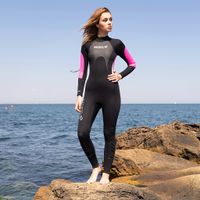Wetsuit
A wetsuit is a protective garment used for watersports such as scuba diving, surfing, windsurfing, kitesurfing, and triathlon. A modern, warm-water wetsuit is mostly made from thin open-cell neoprene, which provides limited thermal protection for activities in cold water, but protects the wearer in warm water from sun exposure. Cold-water wetsuits are built differently, have seams that do not leak and provide good protection from cold water (to about 45°F, or 8°C) for up to 60 minutes in shallow water (less than 10 meters or 33 feet). A wetsuit is usually lined with nylon fabric to strengthen it and make it easy to put on and take off. Some newer wetsuits, usually marketed as "Superflex," contain spandex in addition to neoprene to allow the suit to stretch (the panels of a wetsuit of this type typically contain 15-20% spandex). This counteracts neoprene's tendency to shrink with age; it also allows for some changes in the wearer's size without making the suit uncomfortable.
Wetsuits help to preserve body heat by trapping a layer of water against the skin; this water is consequently warmed by body heat and acts as an insulator. Water conducts heat away from the body approximately 25 times more efficiently than air, so an unprotected individual can succumb to hypothermia even in warm water on a warm day. Wetsuits are made out of closed-cell, foam neoprene, a synthetic rubber that contains small bubbles of nitrogen gas when made for use as wetsuit material. Nitrogen gas has very low thermal conductivity, so it reduces heat from the body (or the water trapped between the body and the wetsuit) from being lost to the water outside of the wetsuit. Some wetsuits of late have even begun to incorporate Merino wool and titanium fibers to add warmth characteristics while keeping the thickness of the suit to a minimum. A wetsuit must have a snug fit to work efficiently; too loose a fit will allow water to escape from between the suit and the body, making the body's heat with it. Flexible seals at the suit cuffs aid in water retention. Neoprene is very buoyant, helping swimmers to better stay afloat, and for this reason, divers need to calculate extra weight values based on the thickness of their suit to achieve neutral buoyancy underwater. The suit loses buoyancy and thermal protection as the bubbles in the neoprene are compressed at depth.
| Portal:Clothing articles |
|---|
|
Chat rooms • What links here • Copyright info • Contact information • Category:Root
